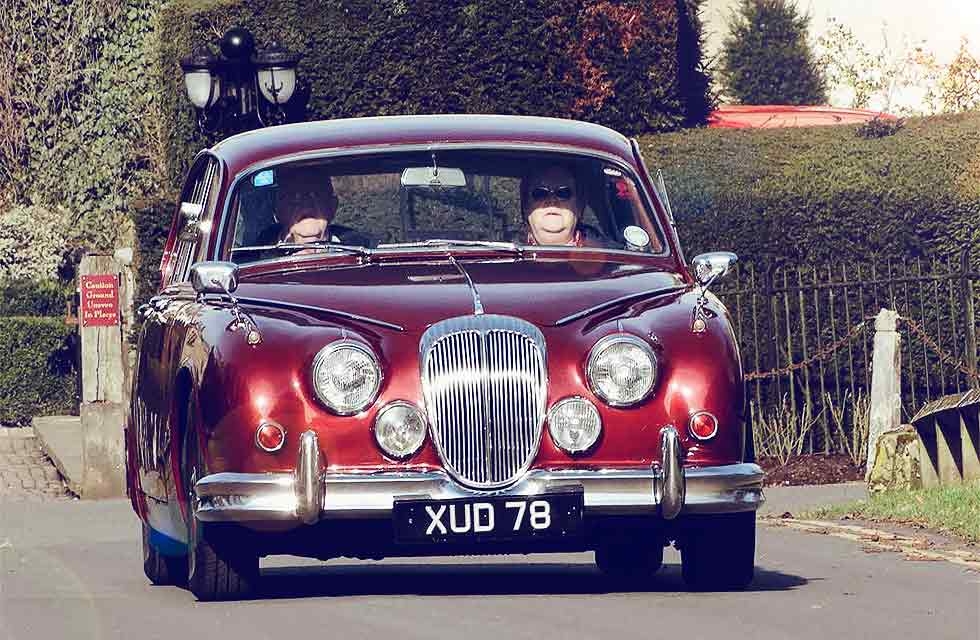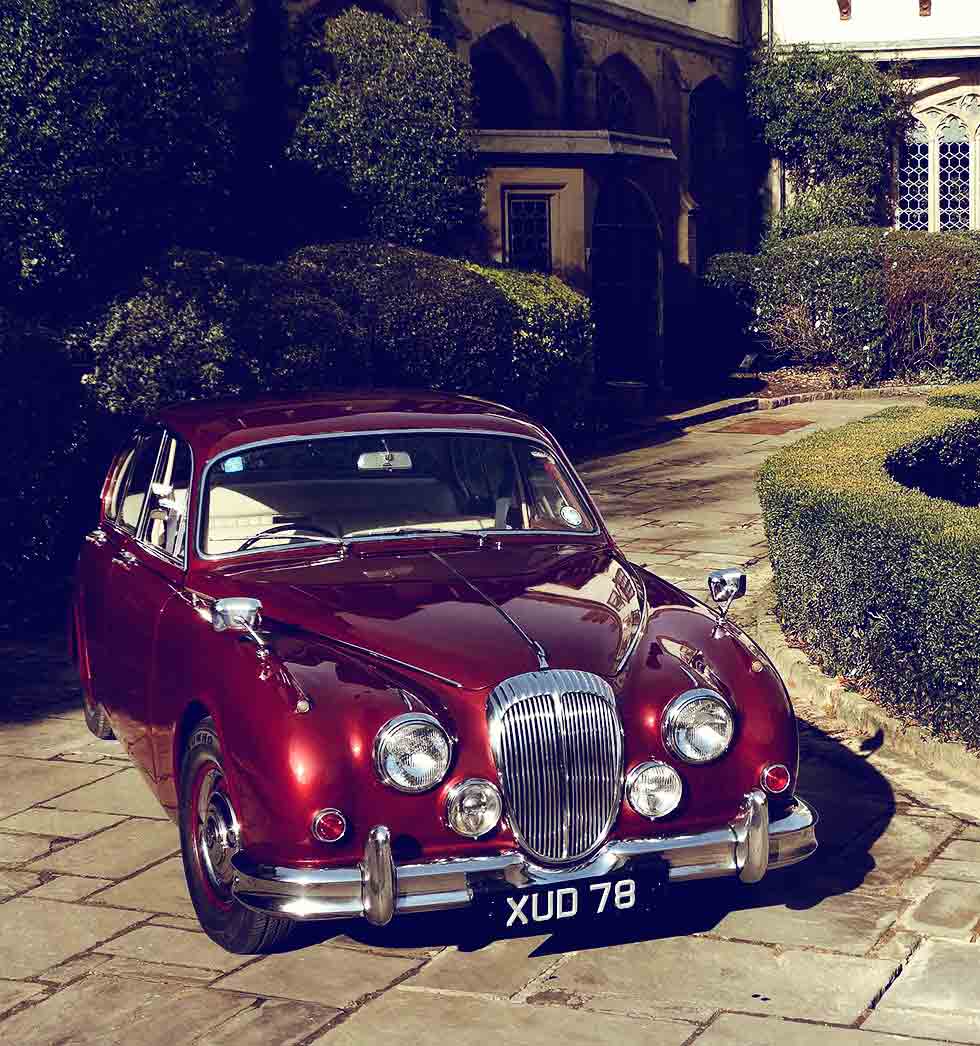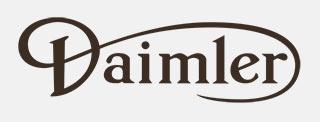
Feature car 1965 Daimler 2½-Litre V8. When it comes to Jaguar Mk2-based models, the Daimler derivative is unique for its added allure of V8 power. We get to experience an excellent survivor – and take a look at the model’s fascinating history. Words & Photography: Paul Guinness.
DAIMLER V8 DELIGHT MK2 BASED OPULENCE
Experiencing the V8 delights of this Mk2-based flagship
When photographing a classic as eye-catching as this 1965 Daimler 2½-litre V8, it’s not unusual to have questions asked by passers-by, most of whom are already aware of the make of the car in question, if not the exact model. On this occasion, however, things are rather different. “Lovely Jaguar,” comments one admirer as we reposition the car for the umpteenth time, while another asks: “Is that the same as Inspector Morse’s?” And as the patient owners explain that their pride and joy is, in fact, a Daimler, an expression of slight confusion inevitably appears on the face of each onlooker.

“It’s something we do tend to experience,” smiles Coventry-based Martin Gliddon, who shares ownership of the Daimler with his partner, Christine Oatridge. “People recognise the shape and assume it’s a Jaguar. We even had one guy wander around the car several times at a show we were at, before telling us that we’d spoiled a beautiful Jaguar by fitting Daimler badges to it.”
“The peak year for the V8-engined compact Daimler was 1964, when a total of 3926 were produced”
Such confusion among the general public is perhaps understandable, given the high profile of the Jaguar Mk2 and the fact that the Daimler 2½-litre is essentially the same in profile and overall shape. The Daimler is, indeed, a derivation of its Jaguar cousin, having been developed using essentially the same bodyshell as the Mk2; but there’s far more to this particular luxury saloon than simple badge-engineering.
This was, of course, the only model derived from the Jaguar Mk2 not to use a straight-six XK powerplant, for the 2½-litre boasted V8 power throughout its relatively short career. This was as a result of Daimler’s development of a compact V8 engine whilst still under BSA management, with the impressively flexible unit making its debut in the SP250 sportster of 1959.
“Sir William Lyons disliked the DP250 concept and ordered that the whole project should be scrapped”
That model marked a major change of direction for Daimler, a marque traditionally known for its large saloons and limousines; but BSA management knew that for Daimler to prosper, it also needed a smaller saloon in its range, one capable of generating healthy sales and much-needed profits.
Although the first Daimler V8 engine test-fitted to a saloon was installed in a Conquest Century, BSA realised that an all-new car was needed if the company was to compete in the compactluxury sector. The controversial DN250 project of 1958 saw the firm creating a Daimler based around the bodyshell of a Vauxhall Cresta PA, but the idea was wisely dropped by the following summer, by which time the plan had changed to basing a new-style saloon (codenamed DP250) around the chassis of the SP250 sports car. In the end, however, with sales of the SP250 failing to hit targets, BSA decided to call time on Daimler, selling the historic brand to Jaguar for £3.4 million in May 1960.
NEW DIRECTION
Sir William Lyons disliked the DP250 concept and ordered that the whole project should be scrapped, although he was convinced that the idea of a compact Daimler had merit – particularly given the excellence of the 2548cc V8 engine that Jaguar had inherited with its acquisition of the marque. And so, just six months after Daimler’s change of ownership, work on a Jaguar-derived compact flagship began in earnest, followed in 1961 by running prototypes based around the Mk2 saloon. The new Daimler 2½-litre V8 was officially launched at the 1962 Earl’s Court Motor Show, although it wasn’t until early the following year that production properly got under way.
“This was, of course, the only model derived from the Jaguar Mk2 not to use a straight-six XK powerplant”
Jaguar carried out numerous changes to the Daimler V8 engine during development of the saloon, which included swapping the cylinder head studs for set bolts (enabling the heads to be removed with the engine still in place), redesigning the sump (for an easy fit between the Mk2’s front suspension units), repositioning the water pump and fitting new-design exhaust manifolds. The V8’s main bearings were also slimmed down in order to create enough space to balance the crankshafts, helping to make this version significantly smoother than the Daimler-designed original. Interestingly, the suspension settings were altered for the Mk2’s transformation into a Daimler, with the less weighty V8 engine (saving 51kg over the regular straight-six) inevitably creating a difference in weight distribution.
Of course, there were no problems when it came to power, with the 2½-litre V8 offering an impressive 140bhp at 5800rpm (and a useful 155lb.ft. of torque at 3600rpm), aided by twin SU HD6 carburettors. Throw into the mix Borg Warner Type 35 automatic transmission and the end result was a luxurious, immensely comfortable saloon with strong performance and – as you’d expect from a Daimler – an effortless driving style.
While Jaguar’s Experimental Department worked on perfecting the Mk2’s adoption of V8 power, the company’s stylists were tasked with making the Daimler derivative look suitably different from the model on which it was based. The most obvious change was to the radiator grille, which followed Daimler tradition via its fluted top, while the bonnet was adorned with a ‘flying D’ mascot. The bootlid sported both ‘Daimler’ and ‘V8’ badging, and was also fitted with a number plate lamp featuring an appropriately fluted chrome surround. The hubcaps (surrounded by handsome Rimbellishers) were given ‘D’ emblems in their centres, while the rear bumper also received the same emblem treatment.
The Daimler 2½-litre V8’s interior benefited from various changes over the standard Jaguar Mk2, including fitment of a split bench seat up front (which meant doing away with the centre console) for extra width and comfort, with everyone on board enjoying fine-quality hide and the usual array of wood-veneered trimmings. The dashboard differed slightly from the Mk2’s thanks to a veneered extension below the central part (housing the radio, heater controls and ashtray), while the Jaguar steering wheel was modified via the inevitable use of a ‘D’ central emblem.
SUPERB SURVIVOR
The 2½-litre V8 in the photographs has been in its current ownership since September 2015, when it marked an interesting change of direction for Martin and Christine – a couple whose previous Jaguar-based ownership had centred around numerous XJS coupes and convertibles as well as an XK8. Craving a classic from an earlier era, as well as the added practicality of a saloon, they couldn’t resist snapping up Ruby (as the Daimler has since been named) when the opportunity arose: “We bought her from Martin Haven, the TV sports commentator who also happens to be a major classic car enthusiast,” explains Christine. “She wasn’t in perfect condition, but she was incredibly solid and rustfree – and with her never having been welded, we were confident she was going to be a good buy.”
The most obvious cosmetic issue in 2015 was a crack in Ruby’s offside front wing, just above the wheelarch, caused when she was accidentally driven into a wheelie bin. It was something that annoyed the car’s new owners, and so the damage was repaired and the wing resprayed – although matching new paint to old proved to be tricky (as is so often the case), which meant there was a very slight mismatch in terms of colour. In the end, just a few months after purchasing the Daimler, Martin and Christine decided to bite the bullet, booking Ruby in for a complete respray in her original hue of Pearlescent Maroon. The work was carried out by Auto Surgery of Coventry, and the end result still looks superb to this day. Prior to that, however, the car was taken to Coventry-based independent Jaguar specialist Cov Cats, where it was treated to a full mechanical inspection and major recommissioning: “We knew when we bought Ruby that there were various jobs to attend to,” explains Martin, “and as we pulled up outside Cov Cats in her we managed to add another item to that list, as she chose that very moment to lose her coolant.
The radiator had seen better days, and so it was sent off for re-coring.” The mechanical work carried out by Cov Cats was extensive but necessary, as Martin and Christine wanted a car that was ready to use, reliable and with no further jobs outstanding. That’s why new rear leaf springs and front coil springs were fitted, along with all new suspension bushes and new Panhard rods at the rear. The brake shoes, calipers and brake lines were all replaced, along with new handbrake cables, and the gearbox (after being drained and refilled) was treated to new mounts. The end result was a ready-to-enjoy classic that – once resprayed – was all set for a new life of pleasure trips, with Martin and Christine having now enjoyed three seasons of attending shows and events in Ruby.
RARITY APPEAL
The day of our photo shoot is clear, dry and bright – ideal weather for hitting the road in a pleasingly well-preserved 2½-litre V8, and so we climb aboard. As Martin manoeuvres the car around the streets near to home, it doesn’t take long to start enjoying the sumptuous seating, the upmarket ambience and – unlike any other Mk2-based model – the muted but glorious ‘burble’ of that classic V8 and its unmistakeable exhaust note. “There’s so much torque from the V8,” explains Martin, as we slow to a crawling speed, “that it will pick up from almost a walking pace in top gear.” Needless to say, Ruby does as requested, providing us with reassuringly swift acceleration from that highest ratio, with no obvious effort and no sign of hesitation.
The overall impression is of a car that’s ideal for long-distance jaunts, which its current owners are happy to undertake: “We’ve been to quite a few shows a distance away,” confirms Christine, “and Ruby always manages to get us there in comfort. Martin tends to cruise at no more than about 60mph – sometimes less – but that’s a relaxing pace for her. She’s got the power to do more, but we like to enjoy the journey. And we also really enjoy people’s reactions when we’re out in her, with plenty of waves and thumbs-up from other drivers.”
Those drivers might, of course, assume that they’re admiring a Jaguar Mk2, as we suggested at the start; and that’s a bit of a shame, given how rare the Daimler derivative is by comparison. This wasn’t a particularly long-lived model, surviving through to 1969 – although from September 1967 it was rebadged as the Daimler V8-250, bringing it more in line with the latest Jaguar branding. With the Mk2 being dropped in favour of the rather less luxurious 240 and 340 saloons at that time, it made sense for the 2½-litre V8 to be relaunched as the V8-250, although happily it didn’t suffer from the same degree of cost-cutting as its Jaguar cousins – with its most obvious difference being the switch to slimmer bumpers and overriders.
The peak year for the V8-engined compact Daimler was 1964, when a total of 3926 examples were produced – just 107 of which were built in left-hand drive guise. Indeed, with Jaguar being far better known than Daimler when it came to crucial export markets (particularly the USA), the Mk2 was inevitably the main overseas success story. This meant that the 2½-litre and V8-250 were built predominantly for the home market, where they were seen as an attractive choice for well-heeled buyers seeking a more traditional offering than the Mk2, a car with a racier image at the time. Such a reliance on home-market sales, however, explains why the total number of V8-engined Daimler saloons produced during their seven years on sale was a fairly lowly 17,883 units. When Martin and Christine’s car was built in 1965, it carried a list price of £1647 including Purchase Tax, making it substantially dearer than the midrange (3.4-litre) Jaguar Mk2 at £1507 and a lot more expensive than the 2.4- litre version at £1389. It was a clever pricing policy, however, enabling the Daimler to be seen as something of a flagship model whilst still undercutting the Rover 3-Litre MkIII – an important British rival, priced then at £1838.
By the time the very last V8-250 rolled off the line in the summer of 1969, the extremely well-received XJ6 was Jaguar’s main saloon focus, bringing with it a new generation of Daimler derivatives. All eyes were on the future, with Jaguar’s latest saloon line-up capturing headlines worldwide. Yet the loss of the V8-engined Daimler marked the end of an era, as well as the end of a well-designed, well-developed powerplant that surely had plenty more to give. From then on, Daimler saloons would be re-badged Jaguars with nothing mechanically different to set them apart from their less expensive cousins. And in that respect, the 2½-litre (and its Daimler V8-250 successor) deserves a special place in the history of one of Britain’s most prestigious marques.
Daimler’s compact V8 engine was originally launched in the SP250. Martin and Christine have owned the Daimler since 2015. The 2½-litre oozes luxury, comfort and plenty of stylish details.
THE RESTORATION
The rear wheel spats were removed and the bodywork fully prepared prior to spraying.
Bumper re-chroming has helped to enhance the appearance of this ’1965 Daimler.
Rust-free and extremely solid, the Daimler was resprayed by Auto Surgery of Coventry.
Mechanical recommissioning was carried out by Cov Cats, an independent specialist.
The underside of Ruby is all original and (remarkably) has never been welded.
Ruby the Daimler enjoys plenty of attention at classic vehicle shows these days.






